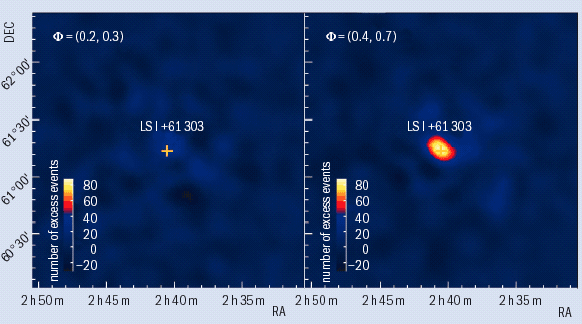
The Major Atmospheric Gamma-ray Imaging Cherenkov (MAGIC) Telescope has discovered variable very-high-energy gamma-ray emission from a microquasar. The telescope, on the island of La Palma, observed the microquasar called LS I +61 303 between October 2005 and March 2006. The observations show a clear variation with time and suggest that gamma-ray production may be a common property of microquasars.
Microquasars are gravitationally bound binary-star systems consisting of a massive ordinary star and a compact object of a few solar masses that is either a neutron star or a black hole. The two stars orbit a common centre and when close enough the mutual tides can cause a sudden transfer of mass from the normal star onto the compact companion. Some of the gravitational energy released in this exchange gives rise to jets of particles ejected at close to the speed of light, together with spectacular emission of radiation. Microquasars appear to be scaled-down versions of quasars, but in this case the small mass of the compact object means that events occur on a much smaller timescale – days rather than years – making them interesting objects to study. They are also a possible source of high-energy cosmic rays.
MAGIC detected LS I +61 303, one of about 20 known microquasars, at a rate of one gamma ray per square metre per month (Albert 2006). The telescope registers gamma rays through the Cherenkov radiation produced by the showers of particles created by the gamma rays as they enter the atmosphere.
LS I +61 303 was observed over six orbital cycles and a clear variability was found that is consistent with the orbital changes in aspect of the compact object (see figure). There is also evidence of periodicity. This shows that the very-high-energy gamma-ray emission is directly related to the interaction between the two stars.
Further reading
J Albert et al. 2006 Science 312 1771.








